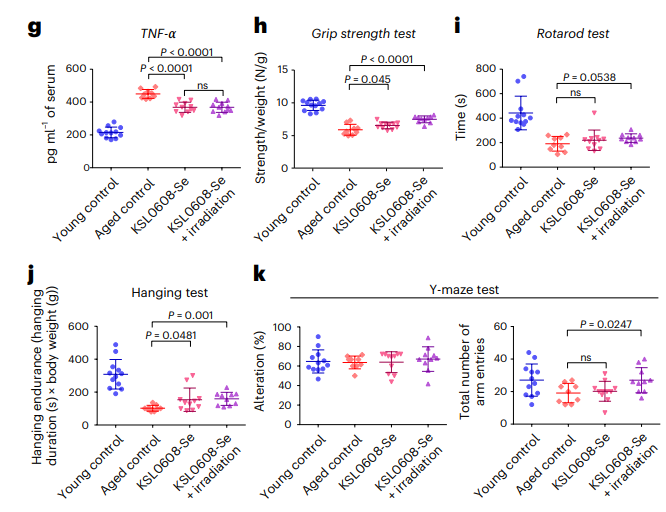Research published in Nature Aging has shown that a photosensitive senolytic drug can be used to selectively remove senescent cells, slowing functional organ aging in mice.
A problem of delivery

Read More
The researchers name three problems with senolytic drugs: specificity to senescent cells (accuracy), controllability of administration (tractability), and effectiveness against multiple types of heterogenous senescent cells (broad-spectrum activity). While prior work has partially addressed these issues [1,2], the authors assert that no prior approach has adequately addressed them all.
To that end, the authors have combined two previously explored approaches. The first is based on a drug that specifically targets the well-known senescence biomarker SA-β-gal [2], and the second consists of photosensitive compounds that only activate in the presence of light [3]. This new compound, KSL0608-Se, chemically combines with SA-β-gal to form a drug that releases cytotoxic levels of reactive oxygen species (ROS) when exposed to 535-nanometer (green) light.
Works only when activated
Much of this paper is devoted to the chemistry of the drug, explaining the various chemical pieces that govern its function. The “Se” in the drug’s name refers to selenium, an element that is vital in trace amounts but a poison in quantity. Here, it is used to enhance the generation of ROS when activated.
In their first experiments, the researchers tested their new compound under different realistic conditions. They found that it remains stable at pH levels found in living beings and maintains its ability to track SA-β-gal over time. They also found that their approach works in principle: it only emits the cytotoxic ROS under the desired conditions.
The next tests involved senescent and cancerous cells. Ovarian cancer is naturally rich in SA-β-gal, while liver cancer is low in it. Fluorescence experiments proved that the drug bound itself to the SA-β-gal in ovarian cancer. The tests with senescent cells proved that KSL0608-Se was able to successfully infiltrate those cells as well, where they concentrated in the lysosomes.
The final cellular tests involved co-cultures of senescent and young cells. KSL0608-Se was found to remove senescent cells, and only those cells, in a dose-dependent manner when affected by light; at the highest measured doses, only about 30% of most senescent cells survived. The compound had no measured cytotoxicity in young cells or cells kept under dark conditions. It was toxic only to cells that expressed sufficient amounts of SA-β-gal, regardless of how they became senescent.
Substantial effects in mice
The researchers found that KSL0608-Se was successful in permeating the tissues of living mice, although it was much more present in older animals than younger animals, particularly the liver and the lungs. Interestingly, KSL0608-Se was shown to have a moderate senolytic effect in older mice even without additional light irradiation, although the additional light amplified the effects.
Multiple biochemical markers of senescence and inflammation, which rise with age, were significantly affected. Physical performance was also positively affected, including in measurements of grip strength, rotarod performance, hanging ability, and maze performance. While the effects were substantial, none of these performance metrics were improved quite to the levels seen in young mice.

RNA sequencing was used to determine gene expression changes. A total of 146 gene expressions that changed with age were affected by this treatment. Most notably, ten genes associated with senescent cell secretions and fibrosis were downregulated.
Conclusion
While the photosensitive nature of this approach can be limiting in certain ways, particularly for larger animals such as human beings, this drug was found to be non-toxic to non-senescent cells and did not seem to have any negative effects on mice, showing a potentially very strong safety profile. Clinical trials of KSL0608-Se will be required to see if its biochemical and performance benefits can be recapitulated in people.
Literature
[1] Johmura, Y., Yamanaka, T., Omori, S., Wang, T. W., Sugiura, Y., Matsumoto, M., … & Nakanishi, M. (2021). Senolysis by glutaminolysis inhibition ameliorates various age-associated disorders. Science, 371(6526), 265-270.
[2] Cai, Y., Zhou, H., Zhu, Y., Sun, Q., Ji, Y., Xue, A., … & Deng, H. (2020). Elimination of senescent cells by β-galactosidase-targeted prodrug attenuates inflammation and restores physical function in aged mice. Cell research, 30(7), 574-589.
[3] Wu, L., Liu, J., Li, P., Tang, B., & James, T. D. (2021). Two-photon small-molecule fluorescence-based agents for sensing, imaging, and therapy within biological systems. Chemical Society Reviews, 50(2), 702-734.




